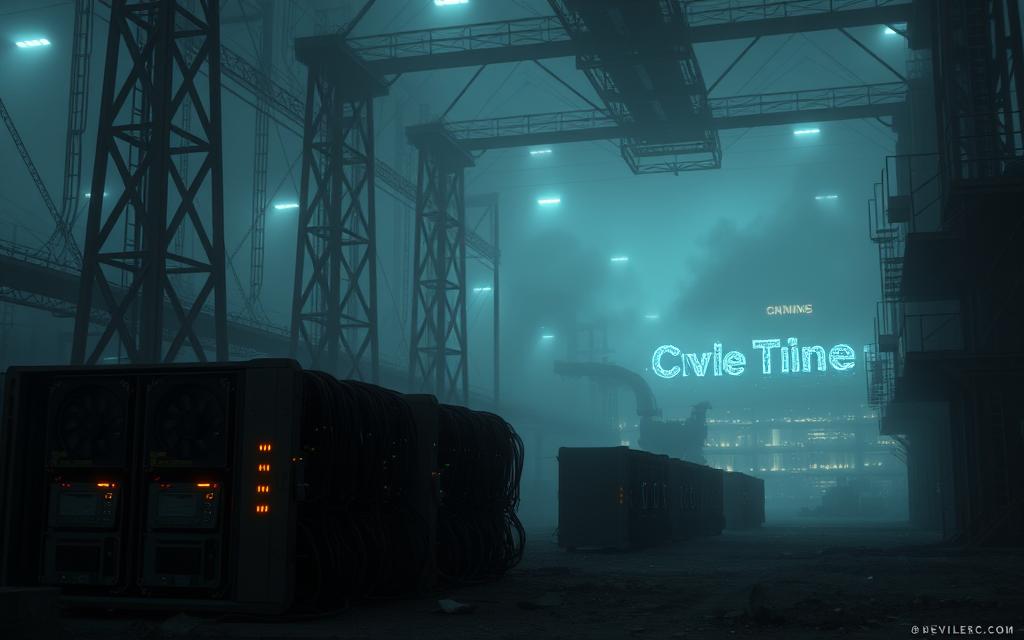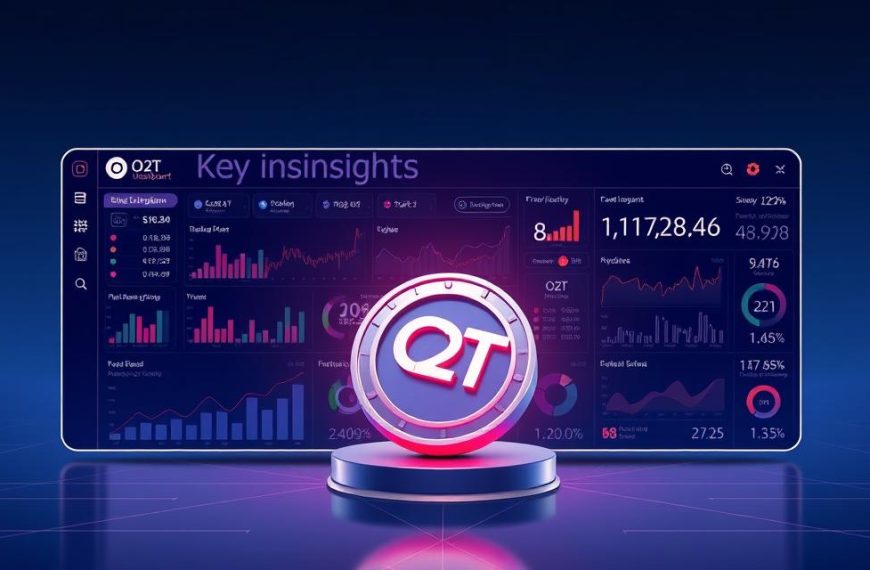This report tackles that question head‑on. The verification network has powered value transfer since 2009 and Bitcoin miners have led reward cycles. Headlines asking whether the sector has ended tend to resurface at inflection points such as the 2024 halving and hardware refreshes.
The present landscape balances rising competition, tighter regulation and energy concerns against better efficiency, institutional interest and renewable integration. The scene has moved from hobbyist rigs to professional operations, raising barriers to entry and changing siting and cost choices.
This introduction frames a pragmatic, data‑led assessment of fundamentals, economics, halving impacts, GPU roles, policy and sustainability. We focus on United States dynamics while noting key international shifts. The aim is not a binary verdict but an evidence‑based view of risks and opportunities for the sector’s future.
Is crypto mining dead in the present market, or simply changing shape?
Today’s landscape shows a shift from bedroom rigs to industrial-scale operations, changing who profits and how in the wider market. Many operators face squeezed margins as difficulty, energy and hardware costs rise. Still, adaptation opens opportunity for efficient, well‑capitalised teams.
The verification process uses proof‑of‑work participants to order and confirm transactions, earning block rewards and fees. That basic function secures networks and preserves long‑term value for users and holders.
Profitability has compressed, yet fee dynamics and institutional demand keep validation economically relevant. Firms with low power costs, hedging strategies and modern rigs can survive and even expand when prices wobble.
- Shift from retail rigs to professional plants with tighter efficiency needs.
- Operational excellence — hardware choice, fee policies, fleet flexibility — drives value capture.
- Strategic moves, such as switching pools or repurposing infrastructure, enhance resilience.
Reduced short‑term returns do not equal structural obsolescence. Scenario planning, not a binary decision, guides operators weighing risk and reward in the present crypto mining landscape.
From 2009 to the present: how mining underpins blockchain networks
Since 2009, distributed participants have kept the ledger auditable by competing to publish valid blocks. This consensus design turns computation into a public good that orders transactions and protects the network.
Proof-of-work, validating transactions, and maintaining a secure ledger
Proof-of-work is a consensus process where dispersed actors expend computational effort to deter fraud and secure the chain. Equipment attempts thousands of hashes per second to solve complex targets; a successful result publishes a verified block to peers.
Blocks, rewards, and the incentives that built the industry
Miners assemble a candidate block from the mempool, usually selecting higher-fee transfers first. The incentive stack combines block rewards and transaction fees, which over the years funded growth and professionalisation.
Why Bitcoin remains central while other cryptocurrencies diverge
Difficulty adjusts to keep issuance steady despite changing hash power. Bitcoin retains the largest security budget and liquidity, so it stays the most mined asset while other projects changed their algorithms or consensus rules, altering their economic paths.
| Feature | Role | Impact over years |
|---|---|---|
| Proof-of-work | Order transactions, secure ledger | Enabled trustless settlement and industry scale |
| Block rewards & fees | Economic incentive | Drove capital investment and professional fleets |
| Difficulty adjustment | Maintain issuance pace | Stabilised block timing despite hash rate swings |
| Protocol divergence | Alternative consensus | Shifted some GPU demand to other sectors |
Profitability under pressure: difficulty, hardware, electricity costs, and price cycles
Rising hash rates and tighter returns force operators to sharpen efficiency and financial controls. In 2023, network growth pushed mining difficulty higher, cutting revenue per unit of hash. That trend requires better rigs, smarter siting and stricter cost discipline.
Mining difficulty and network competition
Difficulty increases as more hash enters the market, compressing payouts. Competition rises in bullish phases, then high-cost sites exit during downturns.
Hardware efficiency and capex/opex
ASICs now lead for high-volume production while GPUs retain niche roles. Capex choices—procurement lead times, depreciation and resale—shape cash flow.
Electricity, cooling, staffing and maintenance drive operating costs. Low and stable power prices remain the decisive siting factor for competitive operators.
Market prices and revenue volatility
Price cycles amplify margin swings. Hedging, treasury rules and pool selection can protect realised revenue. Firmware optimisation and fee strategies yield incremental gains that add up.
| Factor | Impact | Operator response |
|---|---|---|
| Rising difficulty | Lower revenue per hash | Upgrade hardware; improve density |
| Electricity & cooling | Major opex driver | Site selection; energy contracts |
| Hardware capex | Depreciation and lead times | Stagger purchases; lease options |
| Price volatility | Revenue uncertainty | Hedging; conservative burn rates |
Bitcoin halving 2024 and beyond: thinner rewards, shifting market power
The April 2024 halving cut nominal block rewards from 6.25 to 3.125 BTC, an immediate 50% reduction in topline revenue per block.
Fixed costs—electricity, maintenance and staffing—did not fall. That forces lower breakeven thresholds and rewards scale and low-cost energy strategies.
Analysts expect smaller miners and mid-sized operators to face the most pressure. Large-scale firms with procurement leverage and cheaper power can sustain margins and buy stressed assets.
Who gets squeezed and why
- Mechanical effect: a 50% drop in subsidy increases reliance on fee markets and on‑chain activity.
- Unchanged operating costs push breakeven electricity rates down, favouring energy-advantaged sites.
- Balance-sheet strength determines survival; leveraged players are most vulnerable.
Price action matters. If market price appreciation lags the cut, margin compression follows. Elevated fees can partly offset lost reward income during busy periods.
Industry concentration may rise as higher-cost operators capitulate. Strategic responses include fleet upgrades, immersion cooling, demand response programmes and hedging to protect profit.
Looking forward, continual efficiency gains and revenue diversification will shape the sector’s future.
After Ethereum’s move to proof-of-stake: the state of GPU mining
When Ethereum moved away from proof-of-work, many GPU operators had to rethink revenue plans overnight. The Merge removed the primary GPU target and prompted a shift toward ASIC-resistant networks and alternative coins.
The Merge fallout: miners pivot to ASIC-resistant coins and alternate algorithms
Miners reallocated rigs to networks that retained GPU-friendly algorithms. Some joined emergent coin pools; others switched to lesser-known chains with ASIC-resistant code paths.
GPU versus ASIC competitiveness
ASICs deliver superior hash rates and energy efficiency on many proof-of-work tasks thanks to specialised design. That advantage stems from application-specific integrated and other integrated circuits tuned for one function.
GPUs keep value through flexibility. They can handle varied workloads and be repurposed when yields fall. FPGAs offer a middle ground: more efficient than general GPUs but reconfigurable for niche tasks.
| Device | Strength | Where it competes |
|---|---|---|
| GPU | Versatility; re‑deployable to AI and scientific processing | ASIC-resistant algorithms; research and content tasks |
| ASIC | Highest performance-per-watt for specific algorithms | High-volume, low-margin coin production |
| FPGA | Configurable efficiency; lower power than GPUs for some tasks | Specialised algorithms and prototyping |
Profitability now depends on algorithm choice, coin liquidity, electricity price and supply chain timing for new hardware. Skilled tuning—overclocking, memory optimisation and cooling—remains a key operational edge.
- Portfolio approaches and dynamic switching smooth returns.
- Alternate uses in AI and scientific compute help monetise idle capacity.
- Ongoing ASIC advances may narrow GPU niches, making agility essential.
Regulation, geography, and the cost of electricity: where miners can still compete
Policy, power contracts and geography increasingly decide whether an operator wins or exits. Location choices now blend legal clarity, cheap supply and grid access to shape feasible projects.
United States snapshot
The United States presents a patchwork of rules. State policy can sway site economics and permit timelines.
New York enacted restrictions in 2022 that raised compliance burdens. By contrast, Texas remains contested; recent debates affect permit certainty and investor appetite. See reporting on Texas developments at Texas policy and miner relocation.
Global view and procurement strategies
Some countries have outright bans, while others court capital with low tariffs and tax breaks. Operators shift to energy-advantaged countries to secure lower electricity and predictable rules.
- Procurement: PPAs, behind-the-meter deals and co-location at generators cut grid exposure.
- Grid services: Flexible fleets can offer demand response and ancillary services to improve public acceptance.
- Non-tariff factors: Access to skilled labour, cooling water or cold climates often outweigh nominal price differences.
Regulatory agility — active monitoring, compliance and advocacy — is now a core competency for competitive miners facing political and environmental concerns.
Energy consumption, sustainability, and the push toward renewables
The choice of power source now directly affects financeability and community acceptance. Energy consumption sits at the core of project economics and licensing for cryptocurrency mining operations.
Why energy intensity and carbon concerns shape policy and costs
High electricity draw attracts scrutiny and may raise permit hurdles. Regulators and lenders scrutinise carbon footprints when assessing project risk.
Public concerns over emissions can add compliance costs and delay approvals, raising overall costs for operators.
Hydro, wind, and solar: pathways to lower-cost, lower-carbon operations
Hydro offers steady baseload power where available. Wind provides complementary output, while solar paired with storage smooths daytime peaks and supports grid stability.
| Source | Characteristic | Role for operations |
|---|---|---|
| Hydro | Baseload, low carbon | Stable, low-cost supply for large facilities |
| Wind | Variable, seasonal | Pairs well with flexible loads and storage |
| Solar + storage | Predictable day curve | Cheap daytime energy; supports resilience for processing fleets |
Operators also reduce draw with better cooling, immersion rigs and firmware tuning. Using curtailed or stranded power can lower effective electricity bills and improve local grid economics.
Sustainability strategy now links to bankability, insurance and long‑term competitiveness in the network. Future carbon pricing or disclosure rules could shift comparative advantage between jurisdictions.
The evolving landscape: scenarios for the cryptocurrency mining industry
Market forces after the 2024 halving have split probable outcomes into concentration or niche persistence.
Consolidation versus resilience
Larger firms may scale through procurement leverage, cheap power contracts and access to capital. That favours consolidation where performance and contract terms compound advantages over years.
Smaller operators can still survive by specialising. Cooperative pooling, local grid partnerships and operating on ASIC-resistant coins offer practical routes to stay viable.
Technology trajectory and operational gains
Next‑gen chips and targeted firmware upgrades cut unit costs. Cooling advances—air, liquid and immersion—improve density and lower power per hash.
Smarter telemetry and AI-assisted fleet tuning raise uptime and effective yield. Predictive maintenance reduces outages and improves long‑term returns.
| Trend | Effect | Who benefits |
|---|---|---|
| Consolidation | Lower unit opex; market power | Large, capitalised firms |
| Cooling & hardware upgrades | Higher efficiency; lower electricity per unit | Operators investing in technology |
| Algorithm innovation | Shifts suitability between ASICs and GPUs | Flexible, regionally optimised miners |
| AI telemetry & predictive maintenance | Improved uptime and lower failure costs | Any operator with modern ops stack |
Multi‑year scenarios range from continued industrialisation to a diversified ecosystem of regional players. Capital market access will determine who can scale and who must sell assets during low‑margin phases.
Policy interventions may rebalance outcomes if jurisdictions favour decentralised participation or require greener power sourcing. Ultimately, success hinges on operational discipline, smart positioning and adapting technology to local conditions.
Conclusion
The sector now rewards capital, engineering and smart site choice more than hobbyist effort.
The April 2024 halving cut block rewards from 6.25 BTC to 3.125 BTC, raising reliance on fees and efficiency. With higher mining difficulty and tighter margins, disciplined operators that secure low electricity and modern mining hardware sustain profitability.
ASICs and application-specific integrated designs will lead large-scale operations while GPUs find niches or non-mining workloads after Ethereum’s shift. Network security economics and fee dynamics reshape revenue over the years, not erase it.
Regulation, energy consumption and supply chains remain the main uncertainties. Assess local costs, refresh plans and state rules before allocating capital. The landscape remains competitive but investable for disciplined miners who align energy, technology and governance to create value.



















